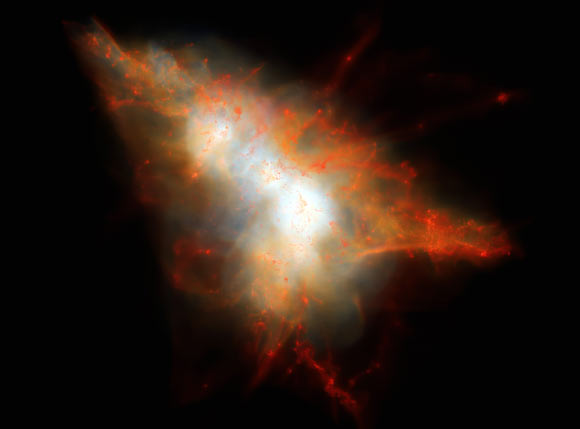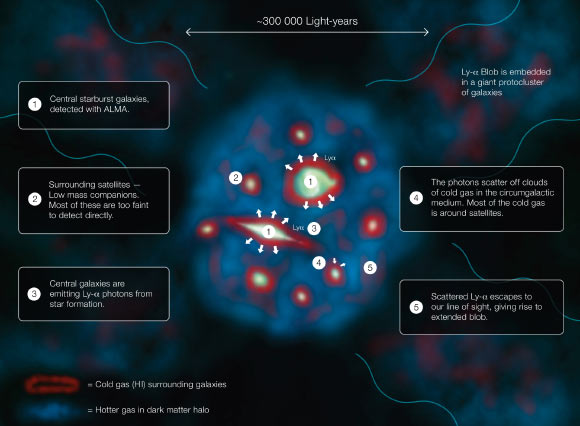
This image shows the Lyman-alpha blob LAB-1. This picture is a composite of two different images taken with the FORS instrument on ESO’s Very Large Telescope – a wider image showing the surrounding galaxies and a much deeper observation of the blob itself at the center made to detect its polarization. The intense Lyman-alpha ultraviolet radiation from LAB-1 appears green after it has been stretched by the expansion of the Universe during its long journey to Earth. These new observations show for the first time that the light from this object is polarized. This means that the giant ‘blob’ must be powered by galaxies embedded within the cloud. Image credit: M. Hayes / ESO.
Lyman-alpha blobs (LAB) are gigantic clouds of hydrogen gas that can span hundreds of thousands of light-years and are found in the distant Universe.
The name reflects the characteristic wavelength of UV light that they emit, known as Lyman-alpha radiation.
Since their discovery, the processes that give rise to LABs have been an astronomical puzzle.
But new observations with the Atacama Large Millimeter/Submillimeter Array (ALMA) may have now cleared up the mystery.

This rendering shows a snapshot from a cosmological simulation of a Lyman-alpha Blob similar to LAB-1. This simulation tracks the evolution of gas and dark matter using one of the latest models for galaxy formation running on the NASA Pleiades supercomputer. This view shows the distribution of gas within the dark matter halo, color coded so that cold gas — mainly neutral hydrogen — appears red and hot gas appears white. Embedded at the center of this system are two strongly star-forming galaxies, but these are surrounded by hot gas and many smaller satellite galaxies that appear as small red clumps of gas here. Lyman-alpha photons escape from the central galaxies and scatter off the cold gas associated with these satellites to give rise to an extended LAB. Image credit: J.Geach / D.Narayanan / R.Crain.
SSA22-Lyman-alpha blob 1 (LAB-1 for short), one of the largest LABs known, was the very first such object to be discovered — in 2000.
This gigantic cloud is about 326,000 light-years across (about three times larger than our Milky Way Galaxy), making it one of the largest known single objects in the Universe.
LAB-1 is embedded in the core of a very young galactic cluster and is located so far away that its light has taken about 11.5 billion years to reach our planet.
A multinational group of astronomers led by University of Hertfordshire scientist Jim Geach has now used ALMA’s ability to observe light from cool dust clouds in distant galaxies to peer deeply into LAB-1.
This allowed them to pinpoint and resolve several sources of submillimeter emission.
The scientists then combined the ALMA images with observations from the MUSE instrument on ESO’s Very Large Telescope.
This showed that two active galaxies are located in the very heart of LAB-1, where they are forming stars at a rate of 150 solar masses per year — over 100 times that of the Milky Way.
Deep imaging with Hubble and spectroscopy at the W. M. Keck Observatory showed in addition that these active galaxies are surrounded by numerous lower mass satellite galaxies that could be bombarding the central galaxies with material, helping to drive their high star formation rates.
The astronomers then turned to a sophisticated simulation of galaxy formation to demonstrate that the giant glowing cloud of Lyman-alpha emission can be explained if UV light produced by star formation in the active galaxies scatters off the surrounding hydrogen gas. This would give rise to the LAB we see.
“Think of a streetlight on a foggy night — you see the diffuse glow because light is scattering off the tiny water droplets,” Dr. Geach said.
“A similar thing is happening here, except the streetlight is an intensely star-forming galaxy and the fog is a huge cloud of intergalactic gas. The galaxies are illuminating their surroundings.”
Scientists think LABs are important because they seem to be the places where the most massive galaxies in the Universe form.
In particular, the extended Lyman-alpha glow provides information on what is happening in the primordial gas clouds surrounding young galaxies, a region that is very difficult to study, but critical to understand.
“What’s exciting about these blobs is that we are getting a rare glimpse of what’s happening around these young, growing galaxies,” Dr. Geach said.
“For a long time the origin of the extended Lyman-alpha light has been controversial. But with the combination of new observations and cutting-edge simulations, we think we have solved a 15-year-old mystery: LAB-1 is the site of formation of a massive elliptical galaxy that will one day be the heart of a giant cluster.”
“We are seeing a snapshot of the assembly of that galaxy 11.5 billion years ago,” he said.
The team’s findings have been accepted for publication in an upcoming edition of the Astrophysical Journal. The article is also publicly available at arXiv.org.
_____
J.E. Geach et al. 2016. ALMA observations of Lyman-alpha Blob 1: halo sub-structure illuminated from within. ApJ, accepted for publication; arXiv: 1608.02941
This article is based on a press-release from the European Southern Observatory.








